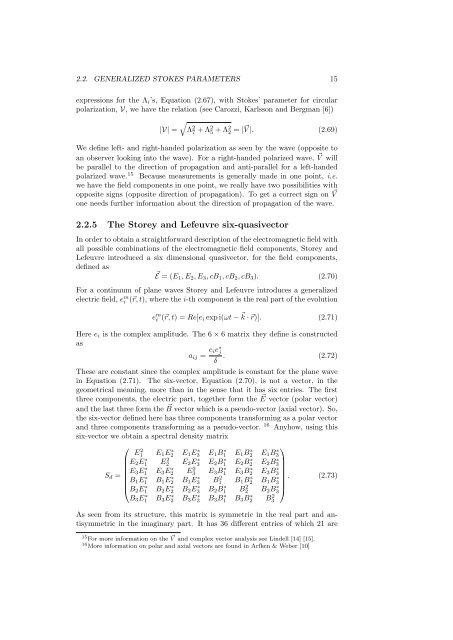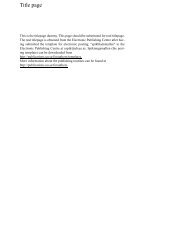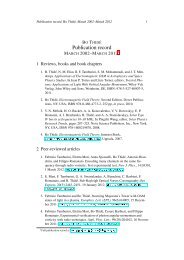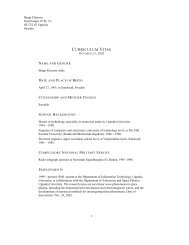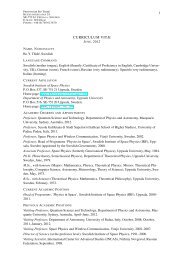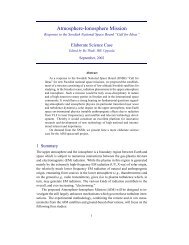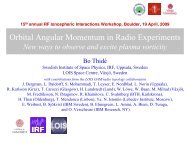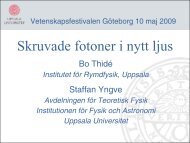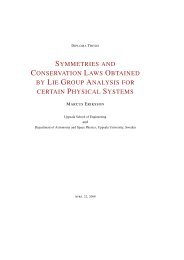Towards a covariant formulation of electromagnetic wave polarization
Towards a covariant formulation of electromagnetic wave polarization
Towards a covariant formulation of electromagnetic wave polarization
Create successful ePaper yourself
Turn your PDF publications into a flip-book with our unique Google optimized e-Paper software.
2.2. GENERALIZED STOKES PARAMETERS 15<br />
expressions for the Λ i ’s, Equation (2.67), with Stokes’ parameter for circular<br />
<strong>polarization</strong>, V, we have the relation (see Carozzi, Karlsson and Bergman [6])<br />
|V| =<br />
√<br />
Λ 2 7 + Λ2 5 + Λ2 2 = |⃗ V |. (2.69)<br />
We define left- and right-handed <strong>polarization</strong> as seen by the <strong>wave</strong> (opposite to<br />
an observer looking into the <strong>wave</strong>). For a right-handed polarized <strong>wave</strong>, V ⃗ will<br />
be parallel to the direction <strong>of</strong> propagation and anti-parallel for a left-handed<br />
polarized <strong>wave</strong>. 15 Because measurements is generally made in one point, i.e.<br />
we have the field components in one point, we really have two possibilities with<br />
opposite signs (opposite direction <strong>of</strong> propagation). To get a correct sign on V ⃗<br />
one needs further information about the direction <strong>of</strong> propagation <strong>of</strong> the <strong>wave</strong>.<br />
2.2.5 The Storey and Lefeuvre six-quasivector<br />
In order to obtain a straightforward description <strong>of</strong> the <strong>electromagnetic</strong> field with<br />
all possible combinations <strong>of</strong> the <strong>electromagnetic</strong> field components, Storey and<br />
Lefeuvre introduced a six dimensional quasivector, for the field components,<br />
defined as<br />
⃗E = (E 1 , E 2 , E 3 , cB 1 , cB 2 , cB 3 ). (2.70)<br />
For a continuum <strong>of</strong> plane <strong>wave</strong>s Storey and Lefeuvre introduces a generalized<br />
electric field, e m i (⃗r, t), where the i-th component is the real part <strong>of</strong> the evolution<br />
e m i (⃗r, t) = Re[e i exp i(ωt − ⃗ k · ⃗r)]. (2.71)<br />
Here e i is the complex amplitude. The 6 × 6 matrix they define is constructed<br />
as<br />
a ij = e ie ∗ j<br />
δ . (2.72)<br />
These are constant since the complex amplitude is constant for the plane <strong>wave</strong><br />
in Equation (2.71). The six-vector, Equation (2.70), is not a vector, in the<br />
geometrical meaning, more than in the sense that it has six entries. The first<br />
three components, the electric part, together form the E ⃗ vector (polar vector)<br />
and the last three form the B ⃗ vector which is a pseudo-vector (axial vector). So,<br />
the six-vector defined here has three components transforming as a polar vector<br />
and three components transforming as a pseudo-vector. 16 Anyhow, using this<br />
six-vector we obtain a spectral density matrix<br />
⎛<br />
⎞<br />
E1 2 E 1 E2 ∗ E 1 E3 ∗ E 1 B1 ∗ E 1 B2 ∗ E 1 B3<br />
∗ E 2 E1 ∗ E2 2 E 2 E3 ∗ E 2 B1 ∗ E 2 B2 ∗ E 2 B ∗ 3<br />
S d =<br />
E 3 E1 ∗ E 3 E2 ∗ E3 2 E 3 B1 ∗ E 3 B2 ∗ E 3 B3<br />
∗ ⎜B 1 E1 ∗ B 1 E2 ∗ B 1 E3 ∗ B1 2 B 1 B2 ∗ B 1 B3<br />
∗ . (2.73)<br />
⎟<br />
⎝B 2 E1 ∗ B 2 E2 ∗ B 2 E3 ∗ B 2 B1 ∗ B2 2 B 2 B3<br />
∗ ⎠<br />
B 3 E1 ∗ B 3 E2 ∗ B 3 E3 ∗ B 3 B1 ∗ B 3 B2 ∗ B3<br />
2<br />
As seen from its structure, this matrix is symmetric in the real part and antisymmetric<br />
in the imaginary part. It has 36 different entries <strong>of</strong> which 21 are<br />
15 For more information on the ⃗ V and complex vector analysis see Lindell [14] [15].<br />
16 More information on polar and axial vectors are found in Arfken & Weber [10]


